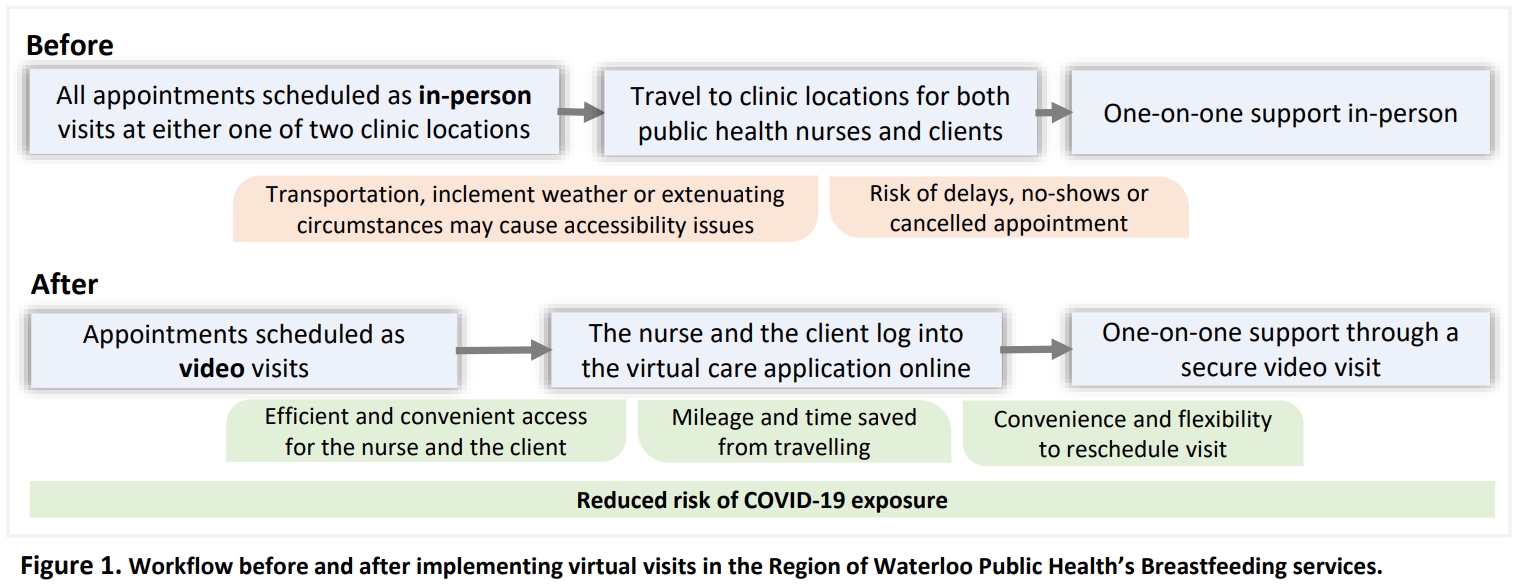Virtual Care: A case study on the impact of providing Public Health Breastfeeding Services via video visits
Breastfeeding is one of the most effective ways to support optimal child health, with breastmilk being the ideal food for infants and providing all the energy and nutrients for the infant’s first months of life and beyond1. The skin-to-skin contact and suckling facilitated through breastfeeding has been associated with physical and emotional benefits for both the baby and the mother.2 Women who breastfeed also have a reduced risk of breast and ovarian cancers.3,4
In Ontario, many mothers are at an increased risk of poor breastfeeding outcomes due to barriers that may impact breastfeeding, including accessibility to services.5 The World Health Organization recommends that children be exclusively breastfed for at least the first six months (and beyond, with the introduction of solid foods) and provides guidelines on breastfeeding counselling, as a public health intervention, to improve breastfeeding practices.6 The rate of breastfeeding among new mothers is an important public health performance indicator and Public Health Units across Ontario offer breastfeeding clinics to support new mothers to initiate and maintain breastfeeding.5,6
Key takeaways
Virtual care enables public health nurses to connect with expecting families and provide care virtually through secure video, allowing access to breastfeeding supports, at a time when public health measures are reinforced to reduce the spread of COVID-19. Virtual care has been associated with a reduction in no-shows and cancelled appointments for breastfeeding services.
The onset of the COVID-19 pandemic posed a significant challenge in providing breastfeeding support to new mothers. With change management support from the eHealth Centre of Excellence, the Region of Waterloo Public Health adopted virtual care to continue the delivery of their breastfeeding support services through secure, online video visits.

Virtual visits allowed our Public Health team to maintain breastfeeding services during the COVID-19 pandemic when we moved to remote work and even when some program resources were reallocated to support other public health emergencies, such as COVID-19 case management and contact tracing. As well as providing the flexibility to virtually meet with clients, implementing eVisits has improved the rates of no-show and cancelled appointments with most clients being receptive to virtual care and finding the technology easy to use on their end.
Emily Barlow, Public Health Nurse
Region of Waterloo Public Health
What were the benefits?
In April 2020, in response to COVID-19, approximately 70% of appointments moved to being video visits, with a smaller percentage of assessments being conducted by telephone, and the smallest percentage of visits being conducted in-person. The rising need for public health to respond to emergency measures (e.g., contact tracing for COVID-19) 7 posed a limitation on public health resources to support the Pregnancy and Breastfeeding Services program, even though the demand for this public health service remained constant. The use of a virtual model of care supported optimized and efficient use of resources. A comparison of no-shows and cancelled appointment rates was completed using the 7-month period after virtual care was first implemented and the same period in the previous year, illustrating that the use of video visits was associated with a reduction in no-shows and cancelled appointments as indicated below:
- Were quick to implement into practice, reducing the risk of exposure to COVID-19 for both staff and clients
- Provided clients with convenient access to public health services, including health teaching and breastfeeding consultation in a virtual setting
- Securely supported the provider’s ability to visually assess the infant behaviour and provide recommendations accordingly
- Provided an efficient appointment for public health nurses to conduct virtual care
Video visits…
Virtual care has had a positive impact on decreasing the number of no-shows and cancelled appointments. Both staff and patients saved mileage and time from travelling, more efficient appointments were conducted virtually, and clients were provided with a convenient option to access this important public health service.
1American Academy of Pediatrics. (2012). Breastfeeding and the use of human milk. Pediatrics, 129(3), e827-e841. Retrieved November 18, 2020, from https://pediatrics.aappublications.org/content/129/3/e827.
2Feldman-Winter, L., & Goldsmith, J. P.; Committee on Fetus and Newborn, Task Force on Sudden Infant Death Syndrome. (2016). Safe sleep and skin-to-skin care in the neonatal period for healthy term newborns. Pediatrics, 138(3), e20161889. Retrieved November 18, 2020, from https://pediatrics.aappublications.org/content/early/2016/08/18/peds.2016-1889.
3Collaborative Group on Hormonal Factors in Breast Cancer. (2002). Breast cancer and breastfeeding: collaborative reanalysis of individual data from 47 epidemiological studies in 30 countries, including 50302 women with breast cancer and 96973 women without the disease. The Lancet, 360(9328):187-195. Retrieved November 18, 2020, from https://www.thelancet.com/journals/lancet/article/PIIS0140-6736(02)09454-0/fulltext.
4Babic, A., Sasamoto, N, & Rosner, B. A. (2020). Association Between Breastfeeding and Ovarian Cancer Risk. JAMA Oncol., 6(6):e200421. Retrieved November 18, 2020, from https://jamanetwork.com/journals/jamaoncology/article-abstract/2763398.
5Best Start Resource Centre. (2015). Populations with Lower Rates of Breastfeeding: A Summary of Findings. Toronto, Ontario, Canada: author. Retrieved November 19, 2020, from https://resources.beststart.org/wp-content/uploads/2018/12/B09-E.pdf.
6WHO. (2018). Guideline: counselling of women to improve breastfeeding practices. Retrieved November 18, 2020, from https://www.who.int/publications/i/item/9789241550468.
7MOHLTC. (2020). Public health management of cases and contacts of COVID-19 in Ontario. Retrieved November 19, 2020, from http://www.health.gov.on.ca/en/pro/programs/publichealth/coronavirus/docs/2019_PH_Mgmt_guidance.pdf
Interested in learning more?
Interested in partnering with us or learning more about
what we can offer you? Please reach out here.
Get the latest resources and insights
-

Webinar on systematically reimagining administrative load in family practice
Sharing some tips, tricks, and key takeaways from our Ideal Primary Care Practice Model webinar,…
-
Summer 2025 Edition of the West Deployment Team Newsletter
Welcome to the Summer 2025 Edition of the West Deployment Team Newsletter for health professionals…
-

Patient experience With eReferral
Patients referred electronically who receive email notifications about their referral report a high level of…
-

Ocean to OTN Integration
To further increase adoption and utilization of the Ontario Health (OH) eConsult Service, Ocean eReferral…